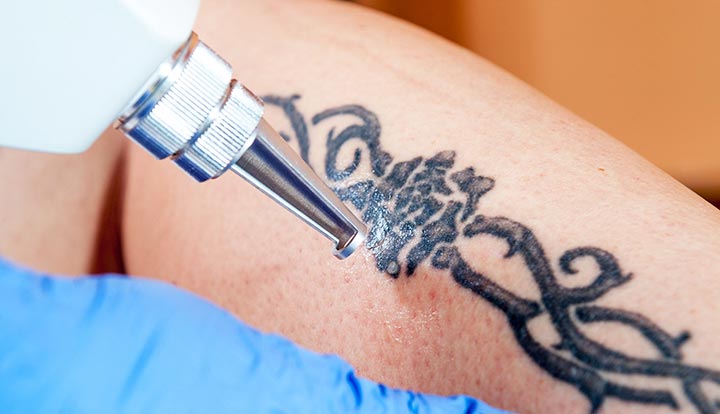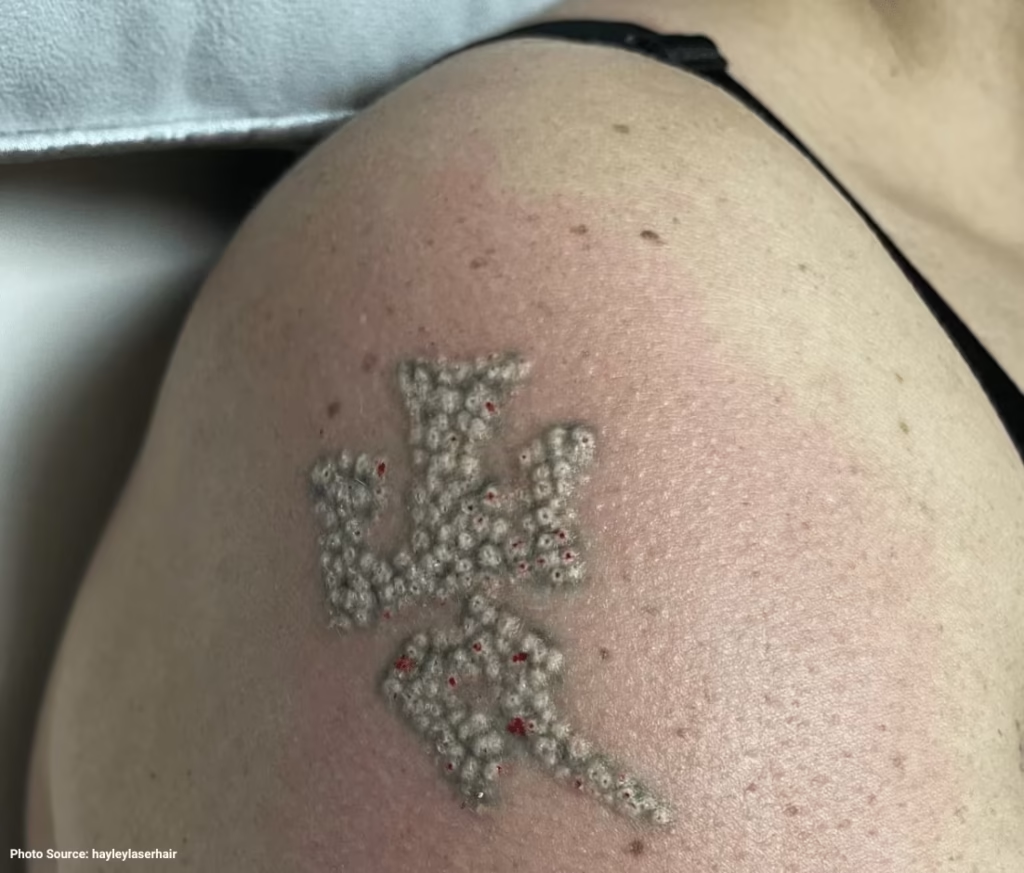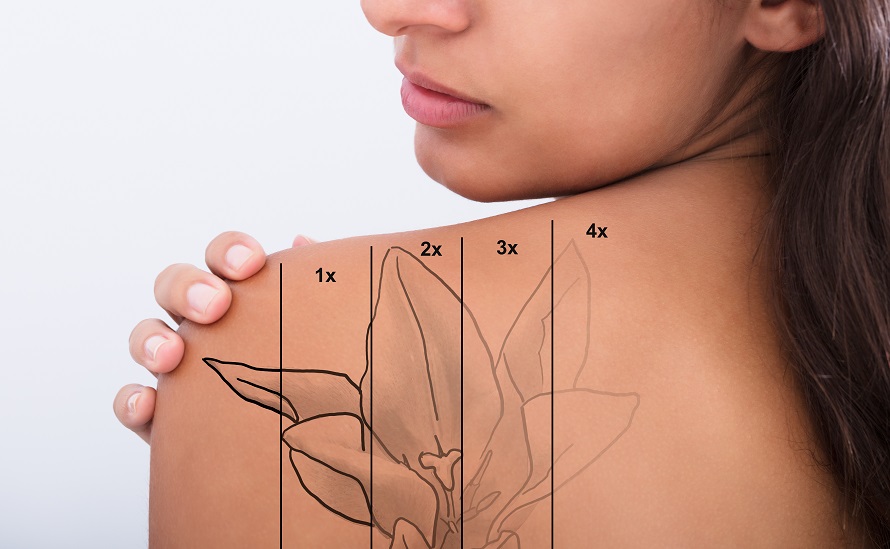Laser tattoo removal has become increasingly sophisticated, offering hope to those who regret their ink decisions.
According to research, approximately one in eight American adults with tattoos experience regret about their body art. If you’re considering laser tattoo removal, proper preparation is essential for achieving optimal results while minimizing risks and complications.
This comprehensive guide will walk you through everything you need to know before your first laser tattoo removal session, from physical preparation to setting realistic expectations about the process.
Read more: Which Tattoo Removal Clinic in Singapore Should You Consider? (Sort by Reviews)
Understanding Laser Tattoo Removal Technology

Before diving into preparation tips, it’s crucial to understand how laser tattoo removal works.
The process uses high-intensity laser beams to break down tattoo ink particles beneath your skin. These fragmented particles are then naturally eliminated by your body’s immune system over time.
Different laser wavelengths target specific ink colors more effectively:
| Laser Type | Wavelength | Best For |
|---|---|---|
| Q-Switched Ruby | 694 nm | Black, green, blue-black inks |
| Q-Switched Nd:YAG | 1064 nm | Black, dark blue inks (safer for darker skin) |
| Q-Switched Alexandrite | 755 nm | Black, dark blue, green pigments |
| Q-Switched Nd:YAG | 532 nm | Red, orange, white, violet, yellow inks |
| Picosecond Lasers | Various | Broad spectrum of colors with better fragmentation |
The choice of laser depends on your tattoo’s colors, your skin tone, and the tattoo’s age and depth.
Related article: A Complete Guide To Laser And Skin Treatments In Singapore
Physical Preparation Requirements
Nutrition and Hydration Protocol
Arriving at your appointment well-nourished and hydrated is crucial for several reasons. The laser treatment can cause discomfort similar to multiple rubber bands snapping against your skin for several minutes.
An empty stomach combined with this sensation can lead to lightheadedness, dizziness, or even fainting.
Consume a substantial meal containing complex carbohydrates and protein at least two hours before your appointment.
Avoid alcohol and excessive caffeine, as these can dehydrate you and potentially amplify pain sensitivity. Drink plenty of water throughout the day leading up to your session to maintain proper hydration levels.
Medication Management
Pain management begins before you enter the treatment room. Take acetaminophen (Tylenol) approximately one hour before your appointment to help reduce discomfort during the procedure.
However, it’s critical to avoid aspirin, ibuprofen, and other blood-thinning medications for at least two weeks prior to treatment, as these increase your risk of excessive bruising and bleeding.
If you regularly take prescription blood thinners, fish oil supplements, or vitamin E, consult with your healthcare provider about temporarily discontinuing these medications.
Create a comprehensive list of all medications and supplements you’re taking to discuss with your laser specialist during your consultation.
Related article: Birthmark Removal in Singapore: Types, Treatments, Risks
Skin Preparation Protocol
Sun Protection Strategy
Your skin’s exposure to ultraviolet radiation significantly impacts both the safety and effectiveness of laser tattoo removal.
Tanned or sunburned skin is more susceptible to adverse reactions, including permanent pigmentation changes, blistering, and scarring. Most reputable laser specialists will refuse to treat tanned skin due to these elevated risks.
Implement a strict sun avoidance regimen for at least four to six weeks before your first session.
When sun exposure is unavoidable, apply broad-spectrum sunscreen with SPF 30 or higher to the tattooed area.
Reapply every two hours and consider wearing protective clothing over the tattoo.
If you develop any level of tan or sunburn, reschedule your appointment to allow your skin time to return to its natural tone.
This waiting period ensures optimal laser penetration and reduces complication risks.
Related article: Guide to Seeing a Dermatologist in Singapore
Area Preparation and Cleansing
The treatment area must be meticulously prepared for optimal laser effectiveness. Shave the tattooed area completely 24 hours before your appointment using a clean, sharp razor.
This removes hair that could otherwise interfere with laser penetration or create additional discomfort during treatment.
On the day of your appointment, thoroughly cleanse the area with mild, fragrance-free soap. Avoid applying any lotions, moisturizers, perfumes, deodorants, or cosmetic products to the treatment zone.
These substances can interfere with laser absorption and potentially cause adverse reactions.
Remove any jewelry or accessories that might interfere with the treatment process. Arrive at your appointment with completely clean, product-free skin in the targeted area.
Related article: The Ultimate Guide to Fractional Lasers in Singapore
Lifestyle Modifications
Smoking Cessation
Nicotine and tobacco use significantly impair your body’s healing mechanisms and substantially reduce tattoo removal success rates.
Smoking restricts blood flow, which is essential for your lymphatic system to effectively remove broken-down ink particles.
Additionally, reduced circulation slows healing and increases infection risks, potentially leading to scarring or permanent skin changes.
Ideally, quit smoking permanently before beginning your tattoo removal journey.
If complete cessation isn’t possible, stop smoking for at least two to four weeks before each treatment session and throughout the entire removal process.
You might like: Laser Skin Pigmentation Treatment in Singapore
Clothing Considerations
Your clothing choices on treatment day directly impact your comfort during and after the procedure.
The treated area will likely feel sunburned and be sensitive to friction for several days following treatment.
Wear loose-fitting, soft clothing that won’t rub against or irritate the treated area. Choose garments that can be easily removed without stretching over the treatment zone.
For tattoos on arms or legs, consider wearing button-up shirts or pants with zippers rather than pull-over items.
Avoid synthetic fabrics that might cause additional irritation, opting instead for natural, breathable materials like cotton.
Bring a change of clothes if necessary, particularly if your regular attire might cause discomfort post-treatment.
Related article: Guide to Wart Removal in Singapore
Setting Realistic Expectations

Understanding Treatment Limitations
Not all tattoos can be completely removed, and results vary significantly based on multiple factors.
While modern laser technology has dramatically improved removal success rates, some tattoos may only fade to a much lighter, less visible state rather than disappearing entirely.
Several factors influence removal success:
Tattoo Characteristics:
- Size and complexity of the design
- Colors used in the original tattoo
- Age of the tattoo
- Quality of the original tattooing work
Body Location:
- Distance from the heart affects blood circulation
- Areas with better blood flow respond more favorably
- Extremities like ankles and fingers are notoriously difficult to treat
Individual Factors:
- Your skin type and tone
- Overall health and immune system function
- Lifestyle factors like smoking status
- Age and healing capacity
Timeline and Session Requirements
Laser tattoo removal is never a single-session process. Most tattoos require between five and fifteen treatment sessions, with complex or colorful designs potentially requiring even more.
Sessions are typically spaced six to eight weeks apart to allow your skin to heal and your body to process the fragmented ink particles.
Professional tattoos with consistent ink distribution often respond more predictably to treatment than amateur tattoos, which may have uneven ink placement and potential scar tissue that complicates removal.
The entire removal process can span anywhere from six months to two years or more, depending on your tattoo’s characteristics and your body’s response to treatment.
Pre-Treatment Consultation Importance
Choosing a Qualified Provider
Select a licensed facility that specializes in laser tattoo removal with experienced, certified technicians.
Your provider should have extensive knowledge of different laser types and wavelengths, understand how various factors affect treatment outcomes, and be able to show you before-and-after photos of their actual work.
During your consultation, your specialist should assess your tattoo comprehensively, discuss realistic expectations, explain the removal process thoroughly, and create a customized treatment plan.
They should also review your medical history and discuss any conditions or medications that might affect treatment safety or effectiveness.
Medical History Disclosure
Provide complete and honest information about your medical history, including any skin conditions, autoimmune disorders, medications, supplements, and previous treatments.
Certain medical conditions or medications can increase complication risks or affect healing processes.
Discuss any previous tattoo removal attempts, allergic reactions you’ve experienced, and your pain tolerance levels.
This information helps your provider customize your treatment approach and take appropriate precautions.
Understanding Pain Management Options
Topical Anesthetics
Many clinics offer topical numbing creams containing lidocaine or other local anesthetics.
These are typically applied 30-60 minutes before treatment to reduce surface sensation.
If you’re considering this option, discuss it during your consultation and arrive early on treatment day to allow adequate numbing time.
Additional Comfort Measures
Beyond topical anesthetics, many providers offer additional comfort measures such as cooling devices, chilled air systems, or cold compresses applied before, during, and after treatment.
Some facilities also provide local anesthetic injections for particularly sensitive areas or larger tattoos.
Understanding your pain management options beforehand allows you to make informed decisions and prepare mentally for the treatment experience.
Financial Preparation
Cost Considerations
Laser tattoo removal typically costs significantly more than the original tattoo. Prices vary based on tattoo size, location, complexity, number of sessions required, and geographic location.
Individual sessions can range from several hundred to over a thousand dollars, with complete removal courses potentially costing several thousand dollars.
During your consultation, request a detailed cost estimate including the expected number of sessions.
Some clinics offer package deals or payment plans to help manage the financial investment required for complete removal.
Insurance and Financing
Most insurance plans don’t cover cosmetic tattoo removal procedures. However, some providers offer financing options or payment plans to make treatment more accessible.
Research these options during your clinic selection process if cost is a significant concern.
Immediate Pre-Treatment Checklist
On the day of your appointment, ensure you’ve completed the following:
Physical Preparation:
- Eaten a substantial meal 2-3 hours prior
- Stayed well-hydrated throughout the day
- Taken acetaminophen if desired for pain management
- Avoided aspirin, ibuprofen, and blood-thinning medications
Skin Preparation:
- Shaved the treatment area 24 hours prior
- Thoroughly cleansed the area with mild soap
- Avoided all lotions, perfumes, and cosmetic products
- Protected the area from sun exposure
Logistical Preparation:
- Worn loose, comfortable clothing
- Removed jewelry or accessories from the treatment area
- Arranged transportation if you’re concerned about post-treatment discomfort
- Brought any required paperwork or identification
Post-Treatment Planning
Immediate Aftercare Supplies
Prepare for post-treatment care by having the following items readily available:
Basic Supplies:
- Gentle, fragrance-free cleanser
- Healing ointment or prescribed aftercare cream
- Non-stick gauze pads
- Medical tape
- Cold compresses or ice packs
- Over-the-counter pain medication (acetaminophen only)
Sun Protection:
- Broad-spectrum SPF 30+ sunscreen
- Loose clothing to cover the treated area
- Hat or other protective accessories if needed
Activity Modifications
Plan to modify your activities for several days following treatment. Avoid strenuous exercise that might cause excessive sweating or friction against the treated area for at least 24-48 hours. Swimming, hot tubs, and soaking baths should be avoided until the area is completely healed.
If your tattoo is in a location that experiences regular friction from clothing or movement, plan to minimize these activities or take extra precautions to protect the area during the healing period.
Special Considerations for Different Skin Types

Darker Skin Tones
Individuals with darker skin tones require special considerations during laser tattoo removal. Longer wavelength lasers, particularly the Nd:YAG 1064 nm laser, are generally safer for darker skin as they’re less likely to cause pigmentation changes.
Treatment settings may need to be adjusted to lower energy levels to prevent hypopigmentation or hyperpigmentation. The healing process may also take longer, requiring extended intervals between sessions.
Sensitive Skin Conditions
If you have sensitive skin, eczema, psoriasis, or other skin conditions, discuss these thoroughly with your provider. You may need modified treatment protocols or additional pre- and post-treatment care measures to prevent flare-ups or complications.
Understanding Potential Side Effects
Common Immediate Reactions
Following laser tattoo removal, expect some immediate reactions that are normal parts of the healing process:
Normal Reactions:
- Redness and swelling around the treated area
- Sensation similar to sunburn
- Temporary darkening of the tattoo
- Mild blistering within 24-48 hours
- Scab formation over the following days
Warning Signs
While some discomfort and visible reactions are normal, certain symptoms warrant immediate medical attention:
Concerning Symptoms:
- Signs of infection (increasing redness, warmth, pus, red streaking)
- Excessive or persistent bleeding
- Severe blistering or burns
- Allergic reactions or unusual skin changes
- Pain that worsens significantly after the first few days
Long-Term Success Factors
Commitment to the Process
Successful tattoo removal requires patience and commitment to the entire process. Skipping sessions, not following aftercare instructions, or trying to rush the timeline can compromise results and increase complication risks.
Maintain realistic expectations throughout the process, understanding that progress may be gradual and that some sessions may show more dramatic results than others.
Lifestyle Maintenance
Continue healthy lifestyle choices throughout your removal journey. Maintain good nutrition, stay hydrated, avoid smoking, protect your skin from sun exposure, and follow all aftercare instructions meticulously.
Your body’s ability to process and eliminate ink particles depends largely on your overall health and immune system function.
Supporting these systems through healthy lifestyle choices enhances your chances of achieving optimal results.
Frequently Asked Questions
How long should I avoid sun exposure before laser tattoo removal?
You should avoid sun exposure and maintain your natural skin tone for at least four to six weeks before your first laser tattoo removal session.
Tanned or sunburned skin significantly increases the risk of complications including permanent pigmentation changes, blistering, and scarring. Most qualified practitioners will refuse to treat tanned skin.
If you must be in the sun, apply broad-spectrum SPF 30+ sunscreen and wear protective clothing over the tattooed area.
What medications should I avoid before laser tattoo removal?
Avoid taking aspirin, ibuprofen, naproxen, and other blood-thinning medications for at least two weeks before your treatment session.
These medications increase your risk of excessive bruising and bleeding during and after the procedure.
Also avoid fish oil supplements, vitamin E, and other natural blood thinners. You can take acetaminophen (Tylenol) for pain management, but consult with your provider about any prescription medications you’re taking regularly.
Should I eat before my laser tattoo removal appointment?
Yes, you should definitely eat a substantial meal containing protein and complex carbohydrates two to three hours before your appointment.
The laser treatment process can be uncomfortable and may last several minutes to over an hour depending on your tattoo size.
Coming to your appointment on an empty stomach can lead to lightheadedness, dizziness, or fainting during the procedure. Stay well-hydrated but avoid excessive alcohol or caffeine consumption.
How should I prepare the tattoo area before treatment?
Shave the tattooed area completely using a clean razor 24 hours before your appointment to ensure optimal laser penetration.
On treatment day, thoroughly cleanse the area with mild, fragrance-free soap and water. Do not apply any lotions, moisturizers, perfumes, deodorants, or cosmetic products to the treatment zone as these can interfere with laser effectiveness and potentially cause adverse reactions. Arrive with completely clean, product-free skin.
What type of clothing should I wear to my laser tattoo removal session?
Wear loose-fitting, comfortable clothing made from soft, natural fabrics like cotton that won’t rub against or irritate the treated area after your session.
Choose garments that can be easily removed without stretching over the treatment zone, such as button-up shirts instead of pullovers for arm tattoos.
The treated area will feel sunburned and be sensitive to friction for several days, so avoid tight or synthetic clothing that might cause additional discomfort.
How many laser tattoo removal sessions will I need?
Most tattoos require between five and fifteen treatment sessions for optimal results, though some complex or colorful designs may need even more treatments.
The exact number depends on factors including your tattoo’s size, colors, age, location on your body, the quality of the original work, and your individual healing response.
Professional tattoos with consistent ink distribution typically respond more predictably than amateur tattoos. Sessions are spaced six to eight weeks apart to allow proper healing.
Is it safe to smoke during laser tattoo removal treatment?
No, smoking significantly impairs the tattoo removal process and should be avoided throughout your entire treatment journey.
Research shows that smokers have approximately 70% lower success rates for complete tattoo removal compared to non-smokers. Nicotine restricts blood flow, which is essential for your lymphatic system to remove broken-down ink particles.
Smoking also slows healing, increases infection risk, and can lead to scarring. Quit smoking entirely or at least stop for several weeks before and after each session.
Can all tattoo colors be completely removed with laser treatment?
While modern laser technology has dramatically improved color removal capabilities, some colors remain more challenging than others.
Black ink responds best to most laser wavelengths and is typically the easiest to remove. Dark blues, greens, and reds also generally respond well to treatment.
However, lighter colors like yellow, pink, light green, light blue, and white can be more resistant to removal and may require specialized lasers or additional treatments.
Your laser specialist can assess your specific tattoo colors and provide realistic expectations.
What should I expect immediately after laser tattoo removal?
Immediately following treatment, expect the tattooed area to appear red and swollen, similar to a sunburn. You may experience mild to moderate discomfort, and the tattoo may temporarily appear darker than usual.
Within 24-48 hours, small blisters may form, which is a normal part of the healing process. Over the following week, scabs will likely develop and eventually fall off naturally.
The entire healing process typically takes two to three weeks before you’re ready for your next session.
How much does laser tattoo removal typically cost?
Laser tattoo removal costs vary significantly based on factors including tattoo size, complexity, location, number of sessions required, and geographic area. Individual sessions can range from a few hundred to over a thousand dollars, with complete removal courses potentially costing several thousand dollars total.
The procedure typically costs more than the original tattoo since multiple sessions are required. Most insurance plans don’t cover cosmetic tattoo removal, but many clinics offer financing options or payment plans.
What are the risks and potential side effects of laser tattoo removal?
Common side effects include temporary redness, swelling, blistering, scabbing, and changes in skin pigmentation that usually resolve over time.
More serious but rare complications can include permanent scarring, infection, keloid formation, and permanent pigmentation changes, particularly in individuals with darker skin tones.
Choosing an experienced, qualified provider and following all pre- and post-treatment instructions significantly reduces these risks. Discuss your individual risk factors during your consultation.
When should I schedule my consultation for laser tattoo removal?
Schedule your consultation at least several weeks before you want to begin treatment to allow time for proper preparation.
During the consultation, your provider will assess your tattoo, discuss realistic expectations, explain the removal process, and create a customized treatment plan. This timing allows you to implement necessary lifestyle changes like smoking cessation and sun avoidance before your first treatment session.
Use this time to research providers thoroughly and ensure you’re choosing a qualified, experienced practitioner.
Can I exercise after laser tattoo removal treatment?
Avoid strenuous exercise for at least 24-48 hours after treatment, particularly activities that cause excessive sweating or friction against the treated area.
Light walking is generally acceptable, but avoid running, weightlifting, contact sports, or any activity that might irritate the healing skin.
Swimming pools, hot tubs, and soaking baths should also be avoided until the area is completely healed to prevent infection. Gradually resume normal activities as the treated area heals and becomes less sensitive.
What happens if I have an adverse reaction to laser tattoo removal?
While serious adverse reactions are rare when treatment is performed by qualified professionals, contact your provider immediately if you experience signs of infection (increasing redness, warmth, pus, red streaking), excessive bleeding, severe blistering, allergic reactions, or pain that worsens significantly after the first few days.
Most providers have protocols for managing complications and can provide appropriate treatment recommendations. Having emergency contact information and knowing when to seek medical attention is part of proper treatment preparation.

